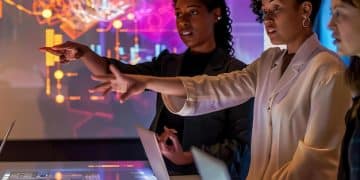The Future of Work: Automation’s Impact on US Jobs by 2030

The future of work in the United States by 2030 will be significantly reshaped by automation, leading to a complex interplay of job displacement and the creation of new roles that demand adaptable skills and innovative workforce development strategies.
The landscape of employment is in constant flux, but few forces promise to redefine it as profoundly as automation. As technology advances at an unprecedented pace, charting The Future of Work: How Automation Will Reshape the US Job Market by 2030 becomes not just an academic exercise, but a critical imperative for policymakers, businesses, and individuals alike. This exploration delves deep into the expected shifts, the challenges, and the immense opportunities that await a workforce on the cusp of an automated era.
The Rise of Automation: A New Industrial Revolution
The concept of automation is far from new. From the first looms to the assembly line, technology has consistently transformed how work gets done. However, what sets the current wave of automation apart is its pervasiveness and cognitive capabilities. No longer limited to repetitive physical tasks, advanced robotics, artificial intelligence (AI), and machine learning are now proficient in areas once thought exclusively human, from data analysis to customer service.
This evolving technological frontier suggests the dawn of a new industrial revolution, one that fundamentally alters the demand for certain human skills while amplifying the value of others. The shift isn’t just about robots replacing humans, but about humans and machines working in increasingly integrated and sophisticated ways. Understanding this nuance is key to anticipating the structural changes within the US job market. The speed of this integration varies across sectors, but its eventual reach is undeniable.
Historic Parallels and Key Distinctions
Throughout history, technological advancements have brought about significant disruption, followed by periods of adjustment and renewed growth. The agricultural revolution shifted populations from farms to cities, and the industrial revolution moved them from homes to factories. Each brought new industries, new job categories, and fundamentally changed societal structures. While there are parallels, several distinctions make the current automation wave unique.
- 🔬 **Velocity and Scale:** The speed at which AI and robotics are developing and being deployed is unprecedented, allowing for rapid widespread adoption across diverse industries.
- 🧠 **Cognitive Capabilities:** Unlike previous automation waves that primarily augmented physical labor, current technologies can perform tasks requiring cognitive abilities like complex data processing, pattern recognition, and even decision-making in defined contexts.
- 🌐 **Global Reach:** Automation is a global phenomenon, meaning the competitive landscape for jobs and industries is no longer confined by national borders, increasing the pressure for countries to adapt swiftly.
The lessons from past revolutions emphasize the importance of adaptability and investment in new skill sets. However, the current iteration demands a proactive and innovative approach to education and workforce development, as the nature of work itself is being redefined.
Predicted Job Displacement and Creation: Understanding the Nuance
The narrative surrounding automation often swings between two extremes: mass unemployment or a utopian future of abundant leisure. The reality, as always, lies somewhere in the middle, characterized by a dynamic interplay of job displacement and the emergence of entirely new roles. By 2030, certain jobs, particularly those involving highly repetitive, predictable tasks – both manual and cognitive – are most susceptible to automation. This includes roles in manufacturing, administrative support, and routine data entry.
However, automation also acts as a powerful catalyst for job creation. New technologies require development, maintenance, and oversight, leading to demand for AI engineers, robotics technicians, and data scientists. Furthermore, the efficiency gains from automation can lead to economic growth, fostering new businesses and services that generate demand for human labor in areas less amenable to automation, such as creative industries, personalized services, and highly complex problem-solving. Predicting the exact number of jobs lost versus gained is challenging, as the scale of creation often depends on how effectively society adapts.
Sectors Most Affected: A Closer Look
While automation will touch nearly every industry, some sectors are poised for more significant transformation. Manufacturing and transportation have already seen substantial automation, and this trend is expected to accelerate. Customer service roles, particularly those involving routine inquiries, are increasingly being handled by chatbots and AI-powered interfaces. Administrative tasks within various industries will also see a reduction in demand as software streamlines processes. Conversely, sectors requiring complex human interaction, creativity, critical thinking, and emotional intelligence are likely to see growth or evolution rather than displacement.
- 🏭️ **Manufacturing:** Continual automation of assembly lines, quality control, and inventory management will increase productivity but reduce demand for manual labor.
- 🚛 **Transportation:** The advent of autonomous vehicles will profoundly impact truck drivers, ride-share operators, and delivery personnel.
- 💻 **Administrative and Office Support:** Routine data entry, scheduling, and document processing will largely be automated.
It’s crucial to distinguish between jobs that will be fully automated and those where only specific tasks will be automated. Many roles will not disappear entirely but will instead be augmented, allowing humans to focus on higher-value activities. This augmentation concept is crucial for understanding the future skill requirements.

The Shifting Skill Landscape: What Will Be Valued
As automation takes over routine and predictable tasks, the skills that differentiate human from machine will become paramount. The workforce of 2030 will require a strong foundation in “human skills” that machines struggle to replicate. These include critical thinking, creativity, complex problem-solving, emotional intelligence, and cross-cultural communication. The ability to innovate, adapt to new technologies, and collaborate effectively with AI will be highly prized. Furthermore, digital literacy will evolve from a basic necessity to a deep understanding of data analytics, cybersecurity, and the ethical implications of technology.
The demand for STEM (Science, Technology, Engineering, and Mathematics) skills will undoubtedly continue to grow, particularly in areas related to AI, robotics, and data science. However, these technical skills will need to be complemented by strong interpersonal and adaptive learning capabilities. The future workforce will not just be tech-savvy but also critically reflective and socially adept, capable of navigating a rapidly changing professional environment. Continuous learning will cease to be an option and become a fundamental necessity for career longevity.
Essential Skills for the Automated Era
Preparing the workforce for 2030 means prioritizing the development of skills that are either uniquely human or that enable effective human-AI collaboration. This goes beyond traditional academic subjects and embraces a holistic approach to learning and personal development.
- 🧠 **Critical Thinking and Complex Problem-Solving:** The ability to analyze information, identify core issues, and devise creative solutions to novel problems.
- 🎨 **Creativity and Innovation:** Generating new ideas, developing original content, and thinking outside established frameworks.
- 🧑🤝🧑 **Collaboration and Teamwork:** Working effectively with diverse individuals, including human colleagues and AI tools, to achieve common goals.
- 🧡 **Emotional Intelligence and Empathy:** Understanding and managing one’s own emotions, and perceiving and influencing the emotions of others, particularly crucial in client-facing or leadership roles.
- 💻 **Digital Fluency and Data Literacy:** Not just using technology, but understanding its underlying principles, interpreting data, and recognizing its potential applications and limitations.
These skills are not easily codified or automated, providing a durable advantage in an increasingly technological workplace. Investing in their development through education and training programs will be crucial for individual and national economic resilience.
Reskilling and Upskilling: The Imperative for Workforce Adaptation
The scale of job transformation necessitates a robust and widespread commitment to reskilling and upskilling initiatives. Reskilling involves training workers for entirely new roles when their current jobs are at high risk of automation, while upskilling focuses on enhancing existing skills to adapt to new technologies within the same profession. Governments, educational institutions, and businesses all have vital roles to play in facilitating this continuous learning process.
For individuals, proactive engagement in lifelong learning will be critical. This might involve formal degree programs, vocational certifications, online courses, or employer-sponsored training. Businesses, in turn, benefit from investing in their existing workforce, as it can be more cost-effective than constant external recruitment, leading to higher employee loyalty and retention. Public policy must also support these efforts through funding, accessible training programs, and incentives for employer participation. Without a concerted effort to adapt the workforce, the potential for social and economic disruption due to automation could be significant.
Key Strategies for Workforce Adaptation
Effective reskilling and upskilling go beyond simply offering courses; they require a strategic, systemic approach that addresses the varied needs of learners and the evolving demands of the labor market. Collaboration between stakeholders is essential for creating sustainable solutions.
- 🎓 **Accessible and Affordable Education:** Ensuring that high-quality training and educational opportunities are available to all, regardless of socioeconomic background or geographic location.
- 🏢 **Employer-Led Initiatives:** Companies developing internal training programs tailored to their specific needs, often in partnership with educational providers.
- 📊 **Data-Driven Program Design:** Utilizing labor market analytics to identify future skill shortages and design training programs that directly address these emerging demands.
- 👨🏫 **Lifelong Learning Culture:** Fostering an environment where continuous learning is embraced as a norm both by individuals and within organizational structures.
Challenges include funding, motivating workers to invest time in learning new skills, and ensuring that training programs are aligned with real industry needs. Addressing these complexities will be paramount to a smooth transition towards an automated future.
The Role of Government and Policy in Managing Change
The profound changes brought by automation necessitate proactive and adaptive governance. Governments have a crucial responsibility to mitigate the negative impacts of automation, maximize its benefits, and ensure an equitable transition for all segments of society. This involves crafting policies that support workforce retraining, strengthen social safety nets, promote innovation, and regulate emerging technologies responsibly. Discussions around universal basic income (UBI), although controversial, highlight the need to consider new models of social support as traditional employment structures evolve.
Investment in public education from early childhood through higher education is fundamental to prepare future generations. Policy can also incentivize businesses to invest in automation that augments human capabilities rather than simply replacing them. Furthermore, international cooperation will be increasingly important, as the challenges and opportunities of automation transcend national borders, requiring shared strategies for research, development, and ethical guidelines. A robust policy framework is not about resisting automation but about channeling its power for societal good.
Policy Levers for an Automated Future
Policymakers have a diverse toolkit at their disposal to shape the trajectory of automation’s impact. These levers can influence innovation, soften economic transitions, and foster a more adaptable and resilient workforce.
- 💸 **Investment in R&D:** Funding research and development in AI and robotics, while also supporting technologies that create new categories of jobs.
- 🎓 **Education Reform:** Overhauling educational curricula to emphasize future-proof skills and integrate digital literacy from an early age.
- 🧑🏢 **Social Safety Nets:** Re-evaluating and potentially strengthening unemployment benefits, income support, and healthcare access to support displaced workers.
- 💼 **Labor Market Regulations:** Adapting labor laws to acknowledge new forms of work, protect gig workers, and ensure fair wages in evolving industries.
Effective policy requires collaboration between government, industry, academia, and labor organizations. The ultimate goal is to create an environment where technological progress translates into broadly shared prosperity, rather than exacerbating inequalities.

Ethical Considerations and Societal Implications
Beyond economic shifts, the pervasive adoption of automation raises profound ethical and societal questions. Issues surrounding data privacy, algorithmic bias, and the potential for increased inequality demand careful consideration. As AI systems become more sophisticated, ensuring transparency in their decision-making processes and accountability for their actions will be critical. The impact on human dignity and the psychological effects of a world where human labor is less central to economic value also warrant exploration.
Societies must grapple with how to distribute the wealth generated by automation and whether current economic models are sufficient to support a changing workforce. The role of work in defining human purpose and community identity will also likely evolve. Addressing these complex ethical and societal implications requires ongoing public discourse, interdisciplinary research, and a commitment to human-centered design in technological development. Ignoring these issues could lead to unforeseen social fragilities in the long term.
Addressing Bias and Ensuring Equity
One of the most pressing ethical concerns is the potential for automation, particularly AI, to perpetuate or even amplify existing societal biases. If algorithms are trained on biased data, their outputs will reflect those biases, leading to discriminatory outcomes in areas like hiring, credit allocation, and even criminal justice. Ensuring equity in an automated world requires proactive measures.
- 🧑💼 **Algorithmic Transparency:** Developing methods to understand how AI systems make decisions and identifying potential sources of bias.
- 🖮️ **Diverse Data Sets:** Training AI models on broad and representative data to reduce inherent biases.
- ⚖️ **Ethical AI Frameworks:** Establishing legal and ethical guidelines for the development and deployment of AI, with a focus on fairness and accountability.
- 👨🤝👩 **Human Oversight:** Maintaining human review and intervention points in automated systems, especially in high-stakes applications.
These considerations extend beyond technical fixes to fundamental questions about societal values and priorities. Public engagement and education on these topics are essential to foster informed decision-making and avoid a future dictated solely by technological capabilities.
Opportunities and Optimism: Beyond the Disruption
Despite the challenges, the future of work in an automated world is not without significant opportunities. Automation has the potential to boost productivity, spur economic growth, and free humans from dangerous or monotonous tasks, allowing them to focus on more creative, strategic, and fulfilling work. It can lead to the creation of entirely new industries and services previously unimagined, addressing complex global challenges in areas like climate change, healthcare, and education. The increase in efficiency could lead to a higher quality of life, with potentially shorter workweeks and greater leisure time.
Furthermore, automation can enhance human capabilities, acting as a powerful tool for augmentation. AI can help doctors diagnose diseases more accurately, assist architects in designing more efficient buildings, and empower educators to deliver more personalized learning experiences. Embracing automation with optimism means focusing on how technology can serve humanity, rather than the other way around. Realizing this potential requires visionary leadership, strategic investment, and a willingness to adapt educational and societal structures to unlock the full promise of this new era.
Potential Benefits for Society and Work
Shifting the perspective from potential threats to opportunities reveals a future where automation significantly contributes to human well-being and societal progress. The gains from increased efficiency and new capabilities are immense.
- 💰 **Increased Productivity and Economic Growth:** Automation can drive down production costs and increase output, leading to greater economic prosperity.
- ⚕️ **Enhanced Human Capabilities:** AI and robotics can augment human skills, leading to better outcomes in fields like medicine, research, and design.
- 🌍 **Solutions to Global Challenges:** Automation can provide tools to address complex issues such as resource scarcity, climate change, and disease more effectively.
- 🧑⚒️ **More Fulfilling Work:** By automating repetitive tasks, humans can focus on creative, strategic, and emotionally resonant work, potentially increasing job satisfaction.
The key to unlocking these opportunities lies in fostering thoughtful implementation and ensuring that the benefits of automation are broadly distributed, creating a more inclusive and prosperous future for all.
| Key Aspect | Brief Description |
|---|---|
| 🤖 Job Transformation | Automation will displace routine jobs while creating new, often higher-skilled roles in tech and creative fields. |
| 🎓 Skill Shift | Demand for human-centric skills like critical thinking, creativity, and emotional intelligence will surge. |
| 💼 Workforce Adaptation | Reskilling and upskilling programs are essential for workers to thrive in the evolving job market. |
| 📊 Policy & Ethics | Governments must enact policies for equitable transition and address ethical AI development. |
Frequently Asked Questions About Automation and the Job Market
No, it’s highly unlikely robots will take all jobs. While automation will displace many routine or predictable tasks, it also creates new jobs in areas of technology development, maintenance, and human-centric roles requiring creativity, critical thinking, and emotional intelligence. The future is more about human-AI collaboration than outright replacement, requiring workforce adaptation.
The most crucial skills will be those uniquely human: critical thinking, complex problem-solving, creativity, emotional intelligence, and interpersonal communication. Digital literacy, data analysis, and the ability to work collaboratively with AI tools will also be highly valued. Continuous learning and adaptability will be essential for career longevity.
To prepare, focus on lifelong learning, emphasizing the development of “human skills” and digital literacy. Explore online courses, vocational training, or traditional education in emerging fields. Be adaptable, embrace new technologies, network with professionals, and always look for opportunities to upskill or reskill in response to market demands.
Automation has the potential to exacerbate inequality if not managed carefully. Those with skills aligned with new technologies may thrive, while those in displaced roles could struggle. Proactive government policies, including investments in education, social safety nets, and equitable access to training, are crucial to ensure the benefits of automation are broadly shared across society.
Governments play a vital role in policy development, including funding for reskilling programs, strengthening social safety nets, and incentivizing businesses to adopt augmenting technologies. They must also address ethical considerations like algorithmic bias and data privacy, fostering an environment where technological progress benefits all citizens equitably.
Conclusion
The journey towards 2030 promises a radical reshaping of the US job market, driven predominantly by the accelerating pace of automation. This transformation is neither an apocalyptic vision of joblessness nor a simplistic utopia of effortless prosperity. Instead, it presents a complex, multifaceted future characterized by significant disruption, unparalleled opportunities, and an urgent imperative for adaptability. While certain roles will undoubtedly diminish or disappear, innovation will foster new industries and job categories, emphasizing distinctly human capabilities such as creativity, critical thinking, and emotional intelligence. Navigating this landscape successfully demands a proactive, collaborative effort from individuals, businesses, and policymakers. Investing in lifelong learning, fostering inclusive workforce development, and establishing robust ethical frameworks for technology will be paramount. Ultimately, the future of work in the US is not predetermined by automation but will be shaped by how thoughtfully and strategically society chooses to embrace and direct its transformative power for collective well-being and sustained progress.





